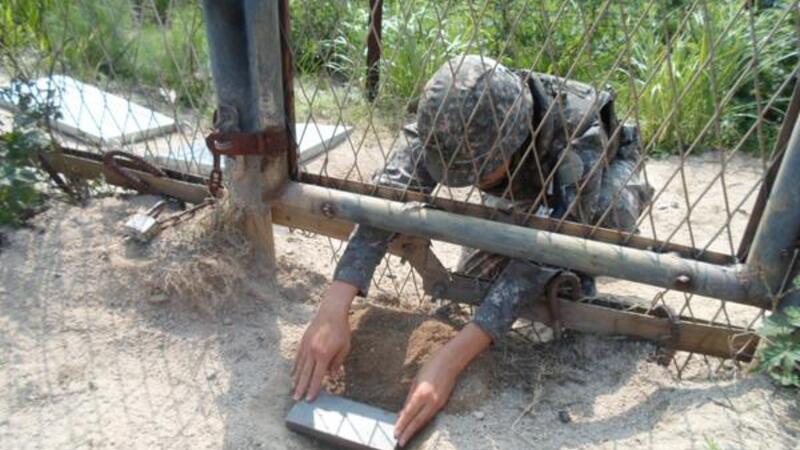South Korea's top military and the United Nations Command in South Korea have alleged that North Korea laid antipersonnel landmines in the southern section of the Demilitarized Zone (DMZ), which stretchs for more than a mile on either side of the 160-mile long border dividing the two Koreas. South Korean soldiers on patrol were maimed by the landmines on August 4. One soldier had both legs amputated while another lost his foot.
Neither South Korea (Republic of Korea) nor North Korea (Democratic People's Republic of Korea) have signed the 1997 Mine Ban Treaty. The United States has not joined either but it has banned its use of antipersonnel landmines, except on the Korean Peninsula due to its "unique circumstances."
The US Campaign to Ban Landmines condemns any use of antipersonnel mines by any actor at any time, including this apparent new mine use by North Korea. The DMZ already contains more than a million landmines, some laid as long ago as the Korean War, which ended in 1953. It is unclear where many are laid, as they can shift from their original location in heavy rains and flooding, moving downstream into agricultural land where they have harmed farmers and other victims.
Immediately after the August 4 explosion, South Korean officials said there was no possibility of North Korean involvement and said recent heavy rains might have displaced the landmines. Then on August 10, South Korea's Ministry of Defense issued the findings of an investigation into the cause of the mine casualties that it conducted conducted on August 5-6 together with the United States-led UN Command, including staff members from the U.S. and from Mine Ban Treaty States Parties Colombia and New Zealand. They presented a detailed account, video footage of the incident, and photographs of the site where the incident occurred.
Their report found that at least three "wooden box" landmines exploded, blowing up South Korean soldiers on patrol. The "box" mines are known as M-57 antipersonnel mines. Manufactured by North Korea, early models of this blast mine were made from wood and later ones from plastic.
According to a statement by South Korea's Joint Chiefs of Staff, North Korean troops planted the landmines on a known South Korean border patrol path sometime between July 24 and August 3, possibly by reaching under a fence. The statement said the mines lacked rust or corrosion, indicating they were newly laid. It called on North Korea to apologise for the incident and punish those responsible
Major General Koo Hong-mo of South Korea's Joint Chiefs of Staff accused North Korea of planting the mines, describing the act as "unthinkable for a normal military." A South Korean Ministry of Defense spokesperson Kim Min Seok described the landmine use as a "baseless act" while a spokesperson for South Korean President Park Geun-Hye said the "landmine attack" constituted a "clear breach" of the armistice agreement that ended the 1950-53 Korean War.
A U.S. Department of State spokesperson condemned the landmine use. The U.S. Department of Defense expressed sympathy to the South Korean soldiers maimed by the landmines and said it remains "in close communication and coordination with the ROK government." Former commanders of the U.S. forces in South Korea also joined the criticism of the landmine use.
During a visit to the DMZ on August 11, the United Kingdom's foreign secretary Philip Hammond condemned the landmine use, calling on North Korea to "explain itself." UN Secretary General Ban Ki-moon "voiced concern" at the reported mine use.
South Korea has announced it will resume its border propaganda operation for the first time in 11 years. A spokesperson remarked that "the loudspeakers will be turned on to denounce North Korea's provocative use of landmines."
On August 14, North Korea denied it laid the landmines in the DMZ, requested proof in the form of additional video footage, and said it would "make no sense" for it to have used the antipersonnel mines as it only uses the weapons in defense.
On August 21, North Korea delivered a statement requesting a Security Council meeting that began with a page-long rebuttal of the evidence that it laid antipersonnel mines in the DMZ, describing the "so-called 'mine explosion'" as a "provocative prefabricat[ed] plot conceived in advance by south Korea for the sake of pursuing another purpose."
It accused South Korea of being inconsistent by stating that South Korea said immediately after the incident that a plastic M14 antipersonnel mine "had gone off due to strong torrential rain" but subsequently accused North Korea of using wooden box mines. North Korea indicated that first explanation was correct, stating that in the DMZ there are "many instances of mines being exploded due to natural force such as torrential rain or fire."
On August 24, after intense negotiations by both sides, North Korea expressed regret that South Korean soldiers were maimed by landmines in the DMZ, but did not admit responsibility for laying them.
The strong accusation and evidence, as well as the denial and responses to the evidence of further landmine use in the already-heavily mined DMZ shows how the stigma against the weapons continues to grow even in countries that do not support the prohibition.
For more information, see:
- Landmine Monitor 2014 ban policy updates on South Korea and North Korea
- Statement by North Korea (August 21, 2015)
- "Counting the cost of South Korea's landmine victims," AFP (June 25, 2015)
- Human Rights Watch briefing note on US Landmine Policy (October 6, 2014)


